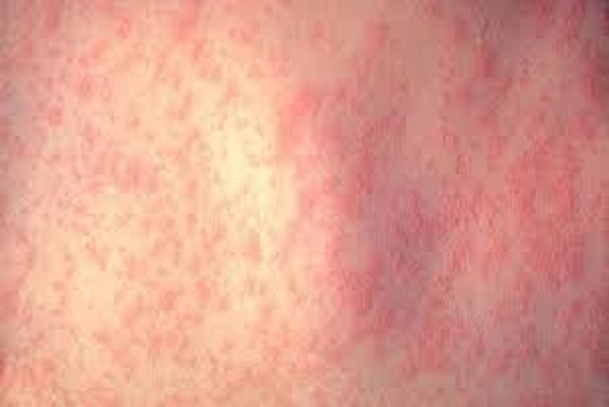 Wash your hands regularly and wear a face mask.
Learn more
Wash your hands regularly and wear a face mask.
Learn more

Introduction
Measles is a childhood infection caused by the ‘rubeola’ virus (not to be confused with ‘rubella’). It was formerly one of the most common infections in the world until the distribution of its vaccines which has reduced its epidemic.
Also called rubeola, measles can be serious, and highly contagious and even fatal for small children. Also, it is an endemic disease, meaning it is continually present in a community, and many people develop resistance. While death rates have been falling worldwide as more children receive the measles vaccine, the disease still kills more than 100,000 people a year, most under the age of 5.
In most people, the disease produces a high fever, a generalized rash that lasts greater than 3 days, cough, runny nose (coryza), and red eyes (conjunctivitis). The complications of measles that result in most deaths include pneumonia and inflammation of the brain (encephalitis). It can spread easily from person to person, especially in those without previous vaccination.
The infected person is highly contagious for 4 days before the rash appears. The measles virus can remain in the air (and still be able to cause disease) for up to 2 hours after an infected person has left a room.
Cases of measles can be dated back as early as the seventh century. However, it was not until 1963 that researchers first developed a vaccine to prevent measles. And before the introduction of the vaccine, the virus was so infectious among all babies due to the fact that it could spread easily. But now, the vaccines as made it impossible for its easy spread among humans.
Epidemic of Measles in Nigeria
Measles is an endemic disease in Nigeria, with recurrent outbreaks occurring at irregular intervals. Its transmission in Nigeria occurs through all months of the year, but peaks in the dry season (February, March, and April).
Measles transmission also sometimes occurs immediately after the end of the rainy season and often reaches epidemic proportions in the dry season. Thus, this has made Nigeria one of only ten countries in the world with measles vaccine coverage of less than 50%; and also ranks her among the 45 countries that account for 94% of the deaths due to measles worldwide.
From 4 January to 23 September 2016, a total of 3,905 suspected cases of measles were reported in four conflict-affected states: 846 in Borno, 2,510 in Yobe, 273 in Adamawa and 276 cases in Gombe state. Of these, 129 cases were laboratory-confirmed.
Also, 19,306 suspected Measles cases with 108 laboratory confirmed cases and 109 deaths {Case Fatality Ratio (CFR), 0. 56%} were reported in 2017 from 36 States and FCT compared with 23,417 suspected cases and 100 deaths (CFR, 0.43%) from 36 States and FCT during the same period in 2016.
In the beginning of the year 2019, the number of measles cases reported in several states steadily continued to rise in Nigeria, when approximately 500 cases were reported as at the end of the second week which was dated 13th January 2019.
With the number of cases rising to over 2, 000 per week as of week 11 (week ending 17th March 2019), a National Measles Emergency Operations Centre (EOC) was activated on 11th March 2019 to coordinate a nationwide response to the outbreak. Multiple reactive vaccination campaigns were conducted to contain the spread of the outbreak, in addition to deployment of multi-disciplinary Rapid Response Teams (RRTs), intensification of surveillance activities and laboratory diagnostics and review of treatment protocols.
Between 1 and 31 August 2019; 1, 336 suspected measles cases were reported from all 36 states of the country. The majority were reported from Katsina (238), Borno (234), Yobe (161), Sokoto (83) and Kaduna (56) states, accounting for 58% of cases reported in the period. The number of cases reported weekly was on a downward trend since week 18 (week ending on 5th May 2019) when over 2, 000 cases were reported compared to week 34 (week ending 25th August 2019) when less than 500 cases were reported. As of week 37 (week ending 15th September 2019), the total number of suspected cases reported was 54, 902 with 275 associated deaths {Case Fatality Ratio (CFR), 0.5%}.
The World Health Organisation (WHO), The United Nations Children's Fund (UNICEF), Gavi Alliance and other health authorities have vaccinated more than 1.2 million children against measles in the North-eastern Borno state. More than 28,000 suspected cases and 89 deaths have been reported since the start of the year 2019, thus making Borno state the most affected state with measles.
Between weeks 44 - 48 (week ending 30th November 2019), a total of 2, 064 suspected cases of measles were reported from 36 states including 7 deaths {Case Fatality Ratio (CFR), 0.3%). Katsina (342), Borno (248), Kaduna (237, Yobe (216), Sokoto (142), Kano (106} and Adamawa (83) account for 67% of all the cases reported in the time period. Between week 1 and 48, a total of 58, 916 suspected cases have been recorded from 759 LGAs in 36 states and FCT with 289 deaths {Case Fatality Ratio (CFR), 0.5%}. Of the 12 467 samples tested, 2 767 were IgM (Immunoglobin) positive for measles.
Presently, the fight against the continuing epidemic rise of measles is on, most especially in the Northeastern part of Nigeria; with many awareness programs being put in place and more vaccination going on.
On the 14th January 2020, The Federal Ministry of Health through the Nigeria Centre for Disease Control (NCDC) has formally announced the inclusion of three new laboratories into national yellow fever/measles/rubella laboratory network. The three new laboratories are the University of Benin Teaching Hospital, Edo, University of Nigeria Teaching Hospital, Enugu and NCDC National Reference Laboratory, Abuja.